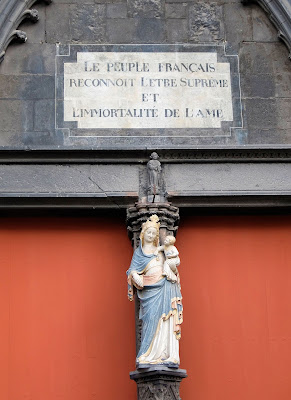Leaving the south of France, our group visited Rodez and settled for the evening
in Clermont-Ferrand, home of the famous Michelin tire company.
Rodez
When entering Rodez from the west, the view of the mighty Gothic
Cathedral of Notre Dame is impressive.

|
|
Cathedral of Notre Dame in Rodez
|

|
|
As you would expect: Saint Mary is everywhere.
|

|
The Annunciation:
Hail, thou that art
highly favored, the Lord is with thee:
Blessed art thou among women.
|
|
|
|
|

|
The window in Elisabeth's chapel shows from
bottom to top: The capture of French troops at
Dunkerque 1940, as POWs sent to work in
STALAG VI C (Stammlager, i.e., main camp),
liberation under the Tricolor with the dove, the
Holy Ghost is the symbol of hope and faith on top.
|
|

|
This window called
Genesis in water
I regarded it as
an attempt to reconcile creation
with evolution. An audacious
display in a Catholic church.
|
|
|
|
Tired of all the impressions, I settled in a cafe at Rodez's central square and
marketplace for an aperitif. The yellow stuff guests were drinking at the other
tables intrigued me. It was a local
gentian schnapps. Following a lively
conversation with people from Rodez and another gentian, I wanted to pay. Still,
those friendly
Ruthénois, as the inhabitants of Rodez are called, had
paid the bill already.
Vive l'hospitalité francaise!

|
| A gentian schnapps |

|
|
Red Baron's frugal but tasty lunch in one of the bistros at the
marketplace
|
Clairmont-Ferrand
Clairmont-Ferrand is the city of Michelin, the famous inventor and maker of
tires. From our hotel, we walked to the Cathedral
Notre-Dame-de-l'Assomption, passing on the way to the Romanesque
Basilica
Notre-Dame du Port.

|
|
Notre Dame du Port, seen from a courtyard
|

|
|
The interior of the Romanesque basilica is even more impressive than the
outside.
|

|
|
The Cathedral Notre-Dame de l'Assomption, as seen from the
roof of our hotel.
|

|
Pope
Urban II
started it all in Clermont in front of the cathedral
on November 27, 1095, when he called for the First Crusade.
|

|
|
The Gothic interior of Notre Dame de l'Assumption
|
A Poor Man's Bible in the form of stained-glass windows for the many illiterates
in the Middle Ages. From bottom to top:
Annunciation, Visitation of Mary, Birth of Jesus, Angels announcing Christ's
birth to the shepherds, Adoration of the child by the shepherds, The Three
Magi contemplating the guiding star, The Magi before King Herod, Adoration of
the Child by the Three Magi.
Aren't we back to icons and Emojis nowadays?

|
|
Stained-glass windows as Biblia pauperum
|
During the French Revolution: The proclamation of the
Supreme Being at a
side entrance of the cathedral:
The French people recognize the Supreme Being and the soul's immortality.

|
|
Where did the poor souls of all those people guillotined end up?
|
Once more, French genius impressed me. I remember that the slogan: "
We French have no oil, but ideas"
was famous during the oil crisis.
Here comes one of those strokes of genius: the tramway in Clermont-Ferrand. It
is simple: Take a bus, guide it by a metallic rail and place the vehicle below
one overhead line. No heavy rail construction is necessary, and no
double catenary, as in the case of a trolley bus, is required since the
guiding rail on the ground serves as the return conductor. In addition, the
tramway smoothly and silently runs on tires; local
Michelin oblige.

|
|
Clermont-Ferrand's tramway
|
Chalon-sur-Saône
On our way back home, we made a stop at Chalon-sur-Saône. It was the time of
the morning market, but two other items caught my attention instead:

|
|
Molière et la Ménagère at the Place du Théâtre by Philippe de
Lanouvelle
|

|
Red Baron wanted to visit Nicéphore Niépcy's Museum
but our tour coach in the back signaled me to hurry up.
|
This ends the tetralogy about my visit to the cathedrals down south:
Rodez, Clermont-Ferrand.
*



















No comments:
Post a Comment